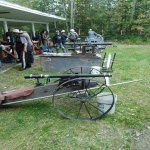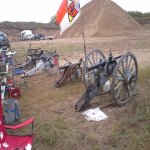Built a gas powered one years ago that shot D cell batteries. Was surprisingly effective. - dan
You are using an out of date browser. It may not display this or other websites correctly.
You should upgrade or use an alternative browser.
You should upgrade or use an alternative browser.
Has any one built a cannon?
- Thread starter rempel429
- Start date
infideleggwelder
CGN Ultra frequent flyer
made several when I was a kid, most successful one cast from lead with a steel liner( broken metal tube from a set of stacking stools). 3/8 bore, walls probably 1/2 inch thick. fired it off with a match, loaded with smokeless shotgun powder and shot from cut open shells about 6 times before my father confiscated it. we were aiming it at his chickens. I believe he still has it somewhere tucked away
made one from clay in art class, one shot fired well, the second... thank god for giant 1984 glasses, i and my brother still have our eyes. collected much of the pieces and glued them back together. still have no idea what made fired clay seem like a good idea.
if I ever see these items again, I`ll post some photos. I know where the clay one is.
made one from clay in art class, one shot fired well, the second... thank god for giant 1984 glasses, i and my brother still have our eyes. collected much of the pieces and glued them back together. still have no idea what made fired clay seem like a good idea.
if I ever see these items again, I`ll post some photos. I know where the clay one is.
billbmcleod
CGN frequent flyer
- Location
- Back very close to Bruce County
When I was in high school in the 60's one of the choices for metal shop was a working desktop .50 cal. cannon. I didn't pick it though as there were lots of real guns at home to use.
But in those days you could pheasant hunt in the morning and leave your shotgun in the principals office for the day and pick it up at 3:30 and hunt on your way home.
But in those days you could pheasant hunt in the morning and leave your shotgun in the principals office for the day and pick it up at 3:30 and hunt on your way home.
Actually yes I have, I regularly fired 300 gr.-1/2 lb charges and I can assure you that the J limit is easily reached many multiple beyond at BP attainable velocities of 1300 fps or so.
Figure out the J value of a 1lb projectile at even 500 fps and guaranteed it would be close to over-limit.
This is a 1/2" bore 8" long.
How are you going to get 300gr of powder and a 1 lb projectile in it?
This^^
fingers, what you claim isn't possible in this barrel. You're really reaching here.
fingers284
CGN Ultra frequent flyer
- Location
- Alberta Cowboy Ranges
Poor picture of mine in foreground:
View attachment 443090
Some belonging to other guys I shoot with.
View attachment 443092
One of the best days of my life was spent watching D and his buddies hit targets from 50 m to 200m with astounding regularity...all smooth bore.
Anyone know what the regulation are wrt fuse ignition devices.
Read an old post that stated that fuse ignited device where not regulated by the firearm act .
SOR 98-464 said that flintlock, wheel lock and matchlock long arms are antiques and not considered firearms for the purposes of licensing but must be stored as modern firearms. All modern made handguns are considered restricted weapons (firearms) regardless of their mechanism (except for flare guns, industrial guns and similar things). Even then, the exempted guns are considered firearms if used in a crime and depending on the wording of prohibitions of possession, may or may not be considered firearms
cheers mooncoon
Dark Alley Dan
CGN Ultra frequent flyer
- Location
- Darkest Edmonton
The OIC is so broadly drafted that a bunch of precise definitions will have to come about as a result of court cases being brought forward. It's like an embryonic bit of legislation, and evidence of sloppy, indifferent construction.
This is what happens when you rush to keep election promises ahead of calling another go-round in the spring. "See what we did? We took guns off the streets!", and all the voting clutchers-of-pearls and the vast horde of folks who are dead center on the Venn diagram of Worries Too Much/Ignorant of Firearms and Firearms Legislation/Watches Too Much News will swallow it up like black market Lik-Em-Stik powder at Fat Kid Camp.
Are black powder mortars on the Bad Gun List, despite never having been used in a criminal manner in Canada, nor being any threat to the public? Maybe. The folks at Armalytics (legit source, BTW) seem to think so. It's in the OIC by name. Will it stand up to a court challenge?
One way to find out...
This is what happens when you rush to keep election promises ahead of calling another go-round in the spring. "See what we did? We took guns off the streets!", and all the voting clutchers-of-pearls and the vast horde of folks who are dead center on the Venn diagram of Worries Too Much/Ignorant of Firearms and Firearms Legislation/Watches Too Much News will swallow it up like black market Lik-Em-Stik powder at Fat Kid Camp.
Are black powder mortars on the Bad Gun List, despite never having been used in a criminal manner in Canada, nor being any threat to the public? Maybe. The folks at Armalytics (legit source, BTW) seem to think so. It's in the OIC by name. Will it stand up to a court challenge?
One way to find out...
When I was a kid I flattened and folded the end of a 1/2" copper pipe(type L), to make a cannon. I think it was the shiny steel ball bearing, sliding perfectly through the inside, that got me motivated. Many, many firecrackers were broken apart to get the proper load. The firecracker fuse happened to burn real fast as I jumped back. Never found the ball bearing but the pipe was recovered, first 2 inches was blown completely flat.
I cut an 18" piece of a locomotive axel (about 12-13 " diameter ), drilled it out on a huge drill press , (it took awhile) . A beer can was a snug fit , and with an ounce of BP and wadding the can , full of cement, was flush with the muzzle . We regularly got about 300 yards from it .
Sort of a coehorn type mortar with a pocket in the bottom of the barrel . It was a crowd pleaser.
But damned heavy .
Sort of a coehorn type mortar with a pocket in the bottom of the barrel . It was a crowd pleaser.
But damned heavy .
Figure out the J value of a 1lb projectile at even 500 fps and guaranteed it would be close to over-limit.
Not even remotely close to correct. 1lb (7000gn) projectile at 500fps gives 3885 ftlbs. Which gives you a grand total of 5152 joules.....a little over 1/2 the "limit".
fingers284
CGN Ultra frequent flyer
- Location
- Alberta Cowboy Ranges
Not even remotely close to correct. 1lb (7000gn) projectile at 500fps gives 3885 ftlbs. Which gives you a grand total of 5152 joules.....a little over 1/2 the "limit".
Yes I just found an energy conversion program online this morning and you are right. I was going on the assumption that If I can get 27,000 ft lbs of energy with 1 lb projectile at 1375 fps ( I have chronographed this with 300 gr of BP) and went with the assumption that 1/3 velocity should be a sliding scale to 1/3 of 27,000 would leave far in excess of 7950 ft lbs but I guess the scale slide isn't uniform.
The proper FPS value required would be 750 to achieve the required "J" level...very doable with that little cannon I bet.
fingers284
CGN Ultra frequent flyer
- Location
- Alberta Cowboy Ranges
This^^
fingers, what you claim isn't possible in this barrel. You're really reaching here.
Actually a column of FF 1/2" in dia requires a tube of only 5.7 inches and that isn't with any compacting and in a test that I was trying to prove the absolute "J" value from that little cannon, I would be compressing that powder to an extreme...so now we have at least 3 inches of open bore left.
But to test within the parameters provided within the OIC ( there are no parameters within the "capable" realm ) I can use any projectile weight or shape to test the cannon. I am under no restraints of normalismn or logical function...The OIC has no limitations...Period. I could use any form of tight fitting hi-friction projectile either internal or external or composite of both to allow the BP pressure time to build and have the projectile in whatever form it is travel far enough to get a cronogragh value to compute with the weight of the projectile.
I have read a lot of posts since may 1st about how "stupid, ignorant or crazy" the writers of that OIC are...but I'm telling you they aren't...their aim was to write up a document that we couldn't circumvent in any way and they have succeeded in spades, by using only the three words "devise & capable of" with no other parameters written in.
Armalytics lists a 3" mortar, homemade as prohibited. There is no mention of cannon ( that I could find with their search). Mortars and cannons are different beasts. I have a cannon that fires weighted pop cans that I made over 40 years ago. It fires by fuse. Much ado about nothing methinks.
Armalytics lists a 3" mortar, homemade as prohibited. There is no mention of cannon ( that I could find with their search). Mortars and cannons are different beasts. I have a cannon that fires weighted pop cans that I made over 40 years ago. It fires by fuse. Much ado about nothing methinks.
my impression of Armalytics is that it is a private interpretation of Canada's firearms laws. I think we need to get an official government interpretation and so far Blair and Trudeau are saying nothing
cheers mooncoon
I believe that I know the specific 3" mortar listed. It is fuse fired. It is also styled so that it looks very much like a generic 3" Stokes mortar. At the time it was made, the CFP insisted that it be registered as a non-restricted firearm - even though it had a touch hole.
Not that this is related to the OIC, but it is likely why it appeared in the FRT.
Not that this is related to the OIC, but it is likely why it appeared in the FRT.











































































